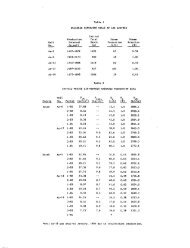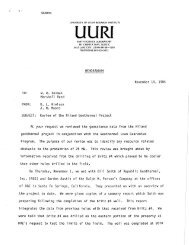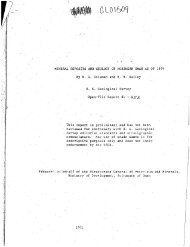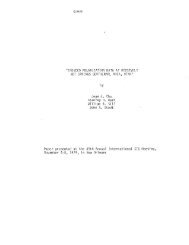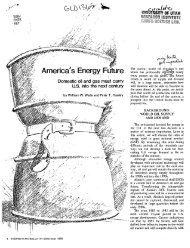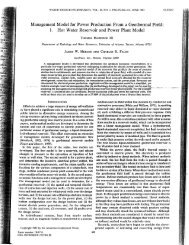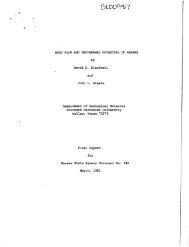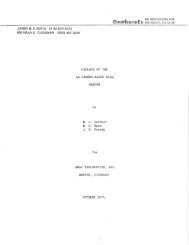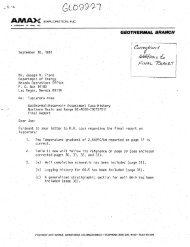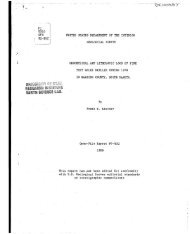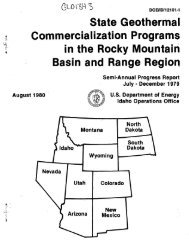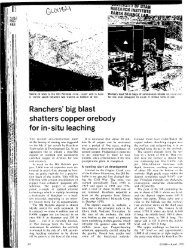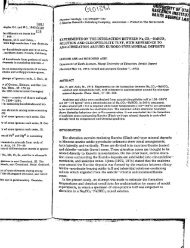%^^^m. - University of Utah
%^^^m. - University of Utah
%^^^m. - University of Utah
Create successful ePaper yourself
Turn your PDF publications into a flip-book with our unique Google optimized e-Paper software.
%<br />
. USGS<br />
OFR<br />
76r428<br />
UNITED STATES DEPARTMENT OF THE INTERIOR<br />
GEOLOGICAL SURVEY<br />
UNIVERSITY OF UTAH<br />
RESEARCH INSTITUTE<br />
EARTH SCIENCE LAB.<br />
CONDITIONS IN THE DEEPER PARTS OF THE HOT SPRING SYSTEMS<br />
OF YELLOWSTONE NATIONAL PARK, WYOMING<br />
' ^ ^ W-7« W^-, <strong>%^^^m</strong>.<br />
by<br />
H. Truesdell and R. O. Fournier<br />
Open-file report<br />
76-428<br />
This report is preliminary<br />
and has not been edited or<br />
reviewed for conformity with<br />
Geological Survey standards
Introduction<br />
Yellowstone thennal areas are scattered over an area <strong>of</strong> nearly<br />
50 X 60 kilometers (Fig. 1) and contain waters <strong>of</strong> diverse compositions.<br />
This has lead to the implicit assumption that Yellowstone consisted <strong>of</strong><br />
discrete hydrothermal systems (e.g., Fournier and Truesdell, 1970). It<br />
is the purpose <strong>of</strong> this paper to suggest that these systems may be<br />
separate only near the surface and that there may exist at depth a large,<br />
relatively homogeneous body <strong>of</strong> water at 340 to 370°C containing about<br />
1,000 ppm NaCl. This deep thermal water flows upwards losing steam into<br />
the near-surface geyser and hot spring systems where it undergoes<br />
variable amounts <strong>of</strong> dilution with cold meteoric water, reaction with<br />
rocks, and further steam loss to produce all <strong>of</strong> the hot spring waters <strong>of</strong><br />
the Park. The evidence for these conclusions is from the application <strong>of</strong><br />
chemical and isotopic geothermometers, from relationships between the<br />
chloride concentrations and subsurface heat contents <strong>of</strong> thermal waters,<br />
from the chemical and isotopic compositions <strong>of</strong> the waters, and from<br />
geophysical evidence.<br />
Geology and Geophysics<br />
As a result <strong>of</strong> an intensive program <strong>of</strong> geological, geochronological,<br />
geophysical, and geochemical studies by members <strong>of</strong> the U.S. Geological<br />
Survey, the volcanic history <strong>of</strong> Yellowstone is known in detail<br />
(Christiansen, 1976). Intense volcanism has characterized the Pleistocene<br />
history <strong>of</strong> Yellowstone Park. Three times in the past two million years<br />
volcanic activity culminating in pyroclastic eruptions has produced large<br />
volumes <strong>of</strong> ash-flow tuffs and caldera collapse. The last <strong>of</strong> these active<br />
periods was characterized by extensive rhyolitic lava flows before and
after the eruption <strong>of</strong> pyroclastic ash and caldera collapse over a 70 x 45<br />
km area. Gravity, seismic, and magnetic studies indicate that partially<br />
molten magma underlies the entire area <strong>of</strong> this caldera at depths below<br />
6 km and possibly extending deeper than 200 km (Eaton et al., 1975;<br />
Trimble and Smith, 1975).<br />
Temperature gradients in lake sediments <strong>of</strong> that part <strong>of</strong> Yellowstone<br />
Lake within the caldera range from 200 to 6000°C/km, but most measurements<br />
are between 600 and 900°C/km. Heat flows calculated from these<br />
measurements average about 15 HFU (Morgan et^ al_. , 1976) and are <strong>of</strong> the<br />
same order as the average <strong>of</strong> 16 HFU for the total area within the Park<br />
east <strong>of</strong> the Continental Divide and <strong>of</strong> 43 HFU within the caldera derived<br />
from chemical measurements (Fournier et^ al., 1976).<br />
The Hot Spring Systems<br />
Hot spring and geyser basins are widely distributed within and just<br />
outside the Yellowstone caldera (Fig. 1). Thermal basins with large flows<br />
<strong>of</strong> hot water generally occupy topographic lows along surface drainages,<br />
and the few topographically elevated thermal areas are characterized by<br />
fumaroles with little water discharge. High chloride thermal waters are<br />
found along the Firehole River in Upper and Lower Geyser Basins, along<br />
the Gibbon River in Norris and Gibbon Geyser Basins, at the west end <strong>of</strong><br />
Shoshone Lake, north <strong>of</strong> Heart Lake, and in a few isolated locations<br />
elsewhere. Thermal areas with fumaroles and acid springs are found east<br />
<strong>of</strong> the Yellowstone River, north <strong>of</strong> Norris Basin, and, to a smaller extent,<br />
in elevated areas adjacent to areas <strong>of</strong> hot water discharge. Waters <strong>of</strong><br />
Mammoth Hot Springs to the north <strong>of</strong> the caldera precipitate travertine
(calcite) as do certain other springs within the geyser basins, although<br />
sinter (silica) precipitation is much more common.<br />
Many analyses <strong>of</strong> Yellowstone thermal waters have been reported since<br />
the early studies <strong>of</strong> Gooch and Whitfield (1888). The most important<br />
compilations <strong>of</strong> analyses are Allen and Day (1935), Rowe et_ al. (1973),<br />
and Thompson ejt al. (197 5). Representative water analyses selected from<br />
the last two are given in Table 1.<br />
Subsurface Temperatures - Chemical Geothermometers and Mixing Calculations<br />
Research drilling in 1929-1930 (Fenner, 1936) and in 1967-1968 (White<br />
et a_l., 197 5) has allowed direct measurement <strong>of</strong> underground temperatures<br />
in parts <strong>of</strong> Yellowstone thermal areas. Unfortxinately, the drilling was<br />
to shallow depths (332 m maximum), and a maximum or "leveling <strong>of</strong>f"<br />
temperature' in a zone <strong>of</strong> fluid upflow was found only in the low-temperature<br />
§ystem at Mammoth. Most <strong>of</strong> our knowledge <strong>of</strong> subsurface temperatures<br />
depends, therefore, on the application <strong>of</strong> chemical and isotopic<br />
geothermometers to hot spring fluids. These geothermometers depend on the<br />
existence <strong>of</strong> temperature-dependent equilibria at depth which are in part<br />
quenched or frozen in during passage to the surface. The theory <strong>of</strong> these<br />
geothermometers has been discussed by Fournier et al. (1974). Because<br />
partial reequilibration commonly does occur during passage to the surface,<br />
these geothermometers may yield only minimum temperatures. Average and<br />
maximum subsurface temperatures indicated by the silica (Fournier and<br />
Rowe, 1966; Mahon, 1966) and Na-K-Ca (Fournier and Truesdell, 1973)<br />
geothermometers for Yellowstone thermal water analyses (compiled by<br />
Rowe et al., 1973, and Thompson et al., 1975) are given in Table 2.
If subsurface mixture with cold, dilute water occurs, temperatures<br />
and concentrations may be sufficiently reduced that reequilibration is<br />
not significant. This is the basis <strong>of</strong> mixing models for warm springs<br />
(Fournier and Truesdell, 1974) and for boiling springs (Truesdell and<br />
Fournier, 1976) which allow the calculation <strong>of</strong> the mixing fraction and<br />
temperature <strong>of</strong> the hot water component. These models have been applied<br />
to Yellowstone analyses (cited previously) and the average and maximum<br />
indicated temperatures are given in Table 2. The average indicated<br />
silica temperatures for thermal areas other than Norris are well below<br />
the theoretical maximum that can be indicated without possible near-surface<br />
precipitation <strong>of</strong> amorphous•silica (White et al., 1956; Fournier, 1973;<br />
Truesdell and Fournier, 1976), but again, except for Norris, the maximum<br />
indicated temperatures are either at or only slightly above that value.<br />
These observations suggest that the indicated temperatures are real and<br />
that near-surface reequilibration occurs in defined aquifers at<br />
temperatures in the range <strong>of</strong> usefulness <strong>of</strong> the boiling spring mixing<br />
model. Higher silica temperatures are indicated at Norris, probably<br />
because <strong>of</strong> unusually rapid upflow <strong>of</strong> thermal waters.<br />
Although maximum subsurface temperatures indicated by the mixing<br />
models are higher than those indicated by the chemical geothermometers,<br />
these temperatures are probably not the actual maximum temperatures <strong>of</strong><br />
water feeding the basins because, in the model for boiling springs, only<br />
the temperature <strong>of</strong> the least mixed water reacliing the surface can be<br />
calculated and because springs suitable for the warm spring mixing model<br />
(which does not have this limitation) are not common in Yellowstone and
have seldom been analyzed. We must look elsewhere for indications <strong>of</strong><br />
the maximum subsurface temperature in Yellowstone.<br />
Isotope Geothermometers<br />
Isotopic equilibration generally occurs much more slowly than<br />
chemical equilibration and is unaffected by pressure variations. Isotope<br />
fractionations are therefore potentially very useful for the thermometry<br />
<strong>of</strong> geothermal systems. Two isotope geothermometers have been applied to<br />
Yellowstone fluids. The distribution <strong>of</strong> carbon 13 between CO2 and CHi|<br />
(AC^[C02, CH14] ) in Yellowstone gases has been measured by Craig (1953;<br />
1963), Gunter (1968), Gunter and Musgrave (1971), and G. L. Lyon (written<br />
commun., 1971). AC^^(C02, CH4) temperatures range from 244 to 390°C<br />
using fractionation factors calculated by Bottinga (1969) (Table 3).<br />
McKenzie and Truesdell (1976) have measured the oxygen isotopic compositions<br />
<strong>of</strong> spring waters and dissolved sulfates <strong>of</strong> Yellowstone and, after making<br />
corrections for the effects <strong>of</strong> dilution and steam separation on the<br />
isotope composition <strong>of</strong> the waters, calculated temperatures near 350°C.<br />
These indicated gas and dissolved,sulfate isotope temperatures are<br />
higher than those from chemical geothermometers because less partial<br />
reequilibration occurs in near-surface aquifers. The kinetic behavior<br />
<strong>of</strong> the gas isotope reactions is unknown, but that <strong>of</strong> the dissolved sulfate-<br />
water geothermometer has been studied by Lloyd (1968). If the subsurface<br />
pH <strong>of</strong> the Yellowstone waters is near 6, as estimated by the methods <strong>of</strong><br />
Ellis (1970) and Truesdell and Singers (1971), the half-time for isotopic<br />
exchange between dissolved sulfate and these waters is calculated to be<br />
25 days at 350°C, 165 days at 250°C, and 525 days at 200°C. The near-<br />
surface aquifers indicated by the mixing models and the chemical
geothermometers are at temperatures near 200±50°C, and dissolved sulfate<br />
in the Yellowstone waters seems to be little changed {
indicated subsurface temperatures <strong>of</strong> all the waters <strong>of</strong> the Park by the<br />
processes <strong>of</strong> adiabatic cooling (steam loss) and dilution by cold water.<br />
If only the Madison and Yellowstone River drainages are considered, it<br />
may be more reasonable to take the intersection <strong>of</strong> the (rather less well-<br />
defined) dilution line <strong>of</strong> Upper and Lower Geyser Basin waters with the<br />
Norris steam-loss line which suggests a deep parent water <strong>of</strong> 336°C and<br />
about 400 ppm chloride (Fournier et^ al., 1976).<br />
If conductive heat loss occurs, water may lose heat without changing<br />
its chloride contents. The path <strong>of</strong> such a water on Figure 2 would be<br />
vertically downward. If the high chloride waters <strong>of</strong> Norris Geyser Basin<br />
were partially cooled by conduction, the calculated deep temperature<br />
would be increased; if the dilute waters <strong>of</strong> Shoshone Geyser Basin were<br />
cooled conductively, the calculated deep temperature would decrease.<br />
The large flows <strong>of</strong> the dilute Shoshone springs and the alignment <strong>of</strong> their<br />
subsurface enthalpy-chloride compositions along a well-defined dilution<br />
line (standard deviation = 5°C for area I; Truesdell and Fournier, 1976)<br />
argue against a large component <strong>of</strong> conductive cooling. It is possible<br />
that partial conductive cooling affects both high and low chloride springs<br />
to produce compensating errors in the calculated deep temperature.<br />
This calculation is based in part on the assumptions that chloride<br />
and heat are transferred to the water deep in the system and are not<br />
modified at shallow levels except by steam loss and dilution. Additional<br />
evidence for this comes from a consideration <strong>of</strong> the isotopic composition<br />
<strong>of</strong> the waters themselves.
-.1 .<br />
Isotopic Compositions bf Waters and the Origin <strong>of</strong> Deep Chloride<br />
It has been shown that most geothermal waters are dominated by .'<br />
meteoric water that circulates deeply and acquires heat and dissolved ;<br />
salts in the process (Craig et_ al_. , 1956; White et al., 1963; Craig,<br />
1963). This deeply circulating meteoric water also becomes enriched in<br />
the heavy isotope <strong>of</strong> oxygen as a result <strong>of</strong> isotope exchange with rock<br />
minerals, and it returns to the surface distinctly different isotopically<br />
from meteoric water <strong>of</strong> shallower circulation. This provides an independent<br />
i<br />
|;<br />
test <strong>of</strong> mixing processes. In Figure 3, the oxygen isotope ratio (expressed<br />
as per mil (6) deviation from SMOW) is shown to be linearly related to the<br />
chloride content for the thermal waters <strong>of</strong> Upper, Midway, and Lower Geyser<br />
Basins, for most <strong>of</strong> Norris Geyser Basin, and for Terrace, Mammoth, and '<br />
Beryl hot spring areas. The isotope-chloride relations for West Thumb ,^<br />
are poorly understood, but may indicate inflow <strong>of</strong> partly evaporated<br />
Yellowstone Lake water. Both linear trends suggest a deep water component<br />
with the composition -12"/^o 60^^ and 800 ppm Cl after flashing to surface i<br />
pressure. These data, taken in conjunction with the isotope temperatures,<br />
strongly suggest that geothermal waters do not acquire significant amounts<br />
<strong>of</strong> additional chloride or undergo significant oxygen isotope exchange with<br />
rock at temperatures much below 300°C. There would be little acquisition<br />
<strong>of</strong> chloride above the base <strong>of</strong> circulation if its source is magmatic<br />
(White, 1957) or if its source is a deep brine that formed during the<br />
early high-temperature phase <strong>of</strong> hydrothermal activity. If a brine is<br />
involved, it must convect deep in the system at near-magmatic temperatures '<br />
and be overlain by a dilute convecting hot spring system with transfer <strong>of</strong> I!<br />
•'\<br />
both chloride and heat at the interface. !'
Evidently additional chloride is not acquired as the dilute water<br />
ascends from depth, either because the water follows well-defined passages<br />
where the original rock chloride already has been leached or because<br />
chloride is not effectively leached from rock at temperatures below 300°C.<br />
Ellis and Mahon (1964) found that the amount <strong>of</strong> chloride leached from<br />
rhyolitic rocks was thirty times greater at 350°C than at 250°C.<br />
Similarly, the exchange <strong>of</strong> oxygen isotopes between coarse grained<br />
silicates and water proceeds exceedingly slowly at temperatures below<br />
300°C (J. R. O'Neil, personal commun., 1975).<br />
Diverse Compositions <strong>of</strong> Yellowstone Thermal Waters<br />
If Yellowstone thermal waters are derived from a single parent water,<br />
as suggested in the previous sections, then this water must be considerably<br />
modified during passage to the surface to produce the observed diversity<br />
<strong>of</strong> water types. Representative analyses <strong>of</strong> Yellowstone waters in Table 1<br />
are taken from compilations <strong>of</strong> Rowe et_ a]^. (1973) and Thompson et^ al.<br />
(1975).<br />
The western part <strong>of</strong> Norris Basin has the most concentrated waters,<br />
consisting <strong>of</strong> Na—' , Cl, and Si02, with only minor contents <strong>of</strong> HCO3, and<br />
with surface pH values near neutral (Table 1, analysis 1). Less<br />
concentrated acid waters with pH values from 2 to 4 and higher SO1+ values<br />
are also found at Norris in major amounts (analysis 2). The Firehole<br />
Basins (Upper, Midway, and Lower Basins) are characterized by more<br />
alkaline (surface pH 8 to 9.5) waters with lower Cl and Si02 contents<br />
and variable higher contents <strong>of</strong> HCO3 and CO3. Waters with the highest Cl<br />
i/val ence is omitted from dissolved species unless reqiiired for clarity.
contents in these basins occur on Geyser Hill in the SE part <strong>of</strong> Upper<br />
Basin (analysis 3); waters from the western parts <strong>of</strong> Upper Basin, from<br />
Midway, and from Lower Basin have lower Cl contents and higher HCO3<br />
contents (analyses 4-8), Waters <strong>of</strong> Heart Lake Geyser Basin are similar<br />
to those <strong>of</strong> Lower Basin (analyses 9 and 10), but waters <strong>of</strong> Shoshone<br />
Geyser Basin are lower in Cl (analyses 11 and 12). Other thermal waters<br />
<strong>of</strong> special interest are those <strong>of</strong> Terrace, Firehole Lake, and Hillside<br />
Springs, where moderate amounts <strong>of</strong> both travertine and sinter are<br />
deposited (analyses 13-15), and those depositing copious travertine at<br />
Mammoth Hot Springs (analysis 16). Finally, in vapor-dominated systems<br />
(White et^ a3^-f 1971) and at higher elevations throughout the Park, acid<br />
waters occur with high sulfate and low chloride (analysis 17).<br />
The Differentiation <strong>of</strong> Yellowstone Thermal Waters<br />
The major near-surface processes producing the varied compositions<br />
<strong>of</strong> thermal waters at Yellowstone include steam separation during-adiabatic<br />
cooling, mixture with cold shallow meteoric waters, and chemical reactions<br />
involving rock minerals, dissolved gases, dissolved components <strong>of</strong> diluting<br />
waters, and atmospheric gases. These processes are summarized in Table 4.<br />
The differentiation <strong>of</strong> thermal waters has also been discussed by Allen and<br />
Day (1935), White (1957), and Ellis (1970).<br />
Steam separation produces changes in water chemistry because salts are<br />
essentially insoluble in low pressure steam (Krauskopf, 1964) and remain<br />
entirely in the liquid phase, while gases partition strongly into the<br />
vapor (Ellis and Golding, 1963; Kozintseva, 1964). The result <strong>of</strong> these<br />
processes is an increase in nonvolatile salts and a decrease in dissolved<br />
gases (principally CO2 and H2S) in the liquid phase. The loss <strong>of</strong> gas<br />
10
Ji>..<br />
produces an increase in pH from about 6 at depth to near 9 at the surface<br />
(Ellis, 1970; Truesdell and Singers, 1971) through the reaction<br />
HC03~ + H"^ = CO2 + H2O.<br />
The effect <strong>of</strong> CO2 loss is greatest in waters with large contents <strong>of</strong> HCO3<br />
such as those from Upper and Lower Geyser Basins (analyses 3-8, Table 1),<br />
so these waters become very alkaline whereas Norris waters, with very<br />
little HCO3, remain near neutral (analysis 1).<br />
Mixture with cold meteoric waters produces the main variations in<br />
the concentrations (but not the ratios) <strong>of</strong> chloride, boron, and other<br />
components not involved in lower temperature rock reactions. Mixture<br />
with cold water also controls the temperatures in subsurface aquifers<br />
where mixture takes place (Truesdell, 1976; Truesdell and Fournier, 1976)<br />
and thus affects temperature-sensitive equilibria such as quartz solution<br />
and ion exchange with feldspars. If temperatures are sufficiently<br />
reduced, steam separation is prevented and a high partial pressure <strong>of</strong> CO2<br />
may be maintained in waters at temperatures near surface boiling. Under<br />
these conditions, the solubility <strong>of</strong> calcite is relatively large (Holland,<br />
1967) and calcium can be leached from the rock. When these dilute, high<br />
PQQ --hiq-h Ca solutions emerge at the surface, they lose COj and deposit<br />
travertine as well as silica. This is the origin <strong>of</strong> the Firehole Lake,<br />
Hillside, and Terrace Springs (analyses 13-15), as well as <strong>of</strong> isolated<br />
springs elsewhere (e.g., analysis 12)..<br />
Most <strong>of</strong> the bicarbonate and part <strong>of</strong> the sodium and potassium in hot<br />
spring waters is produced by reaction <strong>of</strong> dissolved CO2 with volcanic glass<br />
and feldspar to produce mica or clay minerals and bicarbonate and alkali<br />
11
ions (Fournier and Truesdell, 1970),<br />
CO2 + H2O + (Na,K) silicate = HC03~ + (Na'*',K"'") + H silicate.<br />
The coupled increase in HCO3/CI ratios and decrease in C02/other gas<br />
ratios during lateral flow through a near-surface aquifer has been-<br />
demonstrated for Shoshone Geyser Basin (Truesdell, 1976). The effect<br />
<strong>of</strong> this reaction (and <strong>of</strong> dilution) can be seen by comparing analyses 3<br />
and 4, 5, 6, 7 and 8, 9 and 10, and 11 and 12. Norris waters and, to a<br />
lesser extent. Geyser Hill (Upper Basin) waters rise rapidly through<br />
crystalline rock which is not as reactive as the glacial sediments<br />
containing volcanic glass found in other areas, so little CO2 is converted<br />
to bicarbonate.<br />
Sulfate in Yellowstone waters originates in large part from oxidation<br />
<strong>of</strong> H2S by atmospheric oxygen dissolved in meteoric water <strong>of</strong> deep or<br />
shallow circulation (Truesdell, 1976). The theoretical amount <strong>of</strong> SOi^ ion<br />
that can be formed in this manner is 22 ppm from rain water percolating<br />
underground after equilibrating with air at 0°C. This is close to the<br />
observed contents in the waters <strong>of</strong> Upper, Midway, and Lower Geyser Basins<br />
and <strong>of</strong> neutral Norris waters (analyses 1 and 3-8). Areas outside the<br />
caldera may more easily leach sulfate from sedimentary rocks, as is shown<br />
by the high sulfate contents <strong>of</strong> Mammoth and Heart Lake waters (analyses<br />
9, 10, and 16).<br />
Acid waters with extremely high SO^ contents (analysis 17) are<br />
produced by direct superficial atmospheric oxidation <strong>of</strong> H2S to sulfuric<br />
acid in areas <strong>of</strong> drowned fumaroles or steaming ground (White, 1957). The<br />
acid-chloride waters at Norris (analysis 2) probably result from<br />
12
percolation <strong>of</strong> this acid sulfate water into near-surface reservoirs where<br />
it mixes with chloride water from below. The high partial pressure <strong>of</strong> CO2<br />
and large Ca contents <strong>of</strong> Mammoth Hot Springs (analysis 16) may result<br />
from Norris acid chloride waters moving northward along a fault zone and<br />
reacting with sediments consisting in part <strong>of</strong> limestone. The waters are<br />
also considerably diluted with cold meteoric water in the process (Fig. 2).<br />
The Location <strong>of</strong> the Deep Reservoir<br />
The depth to Yellowstone's deep geothermal reservoir is estimated to<br />
be more than 2 or 3 kilometers and less than 5 kilometers. The maximum<br />
temperatures indicated by the enthalpy-chloride relations and the isotope<br />
geothermometers are in the range 340 to 390°C. The minimum depth at which<br />
hot water can remain liquid is determined by the pressure <strong>of</strong> an overlying<br />
column <strong>of</strong> vapor-saturated water. For these temperatures, this minimum<br />
depth is 2 to 3 kilometers (Haas, 1971; Manuel Nathenson, written commun.,<br />
1974). The existence <strong>of</strong> overpressure in Yellowstone systems <strong>of</strong> up to 6.2<br />
bars (White et al^. , 1975) would only decrease this depth by about 100<br />
meters. If the water is not saturated with steam throughout, the depth to<br />
the reservoir will be greater.<br />
The reservoir cannot be very deep in Yellowstone because geophysical<br />
evidence for a mass <strong>of</strong> molten rock (magma) at depth suggests that this<br />
magma may be as shallow as 5 kilometers (Eaton et^ ^}L'' 1975; Trimble and<br />
Smith, 1975). The maximum depth <strong>of</strong> epicenters <strong>of</strong> earthquakes occurring<br />
to the WNW <strong>of</strong> Yellowstone Park changed abruptly from 15 kilometers<br />
outside the Yellowstone caldera to 5 kilometers inside in the vicinity<br />
<strong>of</strong> Norris Geyser Basin (Trimble and Smith, 1975).<br />
13
Geologic studies <strong>of</strong> Yellowstone suggest that, at estimated aquifer<br />
depth <strong>of</strong> 3±1 kilometers within the caldera, the rocks are ash-flow tuffs,<br />
rhyolitic flows, and sediments (R. L. Christiansen, personal commun.,<br />
1975). These units would provide a suitable reservoir for the deep hot<br />
fluid. Fractures in otherwise impermeable rocks also may create an<br />
aquifer that extends across rock types.<br />
It is probable that the deep aquifer underlies the entire area<br />
within the Yellowstone caldera (Fig. 1). Temperature measurements in the<br />
sediments <strong>of</strong> Yellowstone Lake indicate gradients <strong>of</strong> 500 to 900°C per<br />
kilometer for the area within the caldera, and heat flows calculated from<br />
these gradients (Morgan et al., 1976) are similar to those derived from<br />
chloride-heat budgets for thermal water <strong>of</strong> the Madison and Yellowstone<br />
River drainages (Fournier et_ al^., 1976) . It is possible that the<br />
relatively impermeable lake sediments prevent the formation <strong>of</strong> the zones<br />
<strong>of</strong> intense convective upflow separated by zones <strong>of</strong> diffuse downflow<br />
characteristic <strong>of</strong> the rest <strong>of</strong> the caldera.<br />
Thermostatic Processes in High Temperature Systems<br />
The geothejrmal systems <strong>of</strong> Yellowstone obtain their heat from cooling<br />
magma which probably is at temperatures above 600°C. Deeply circulating<br />
dilute water, as discussed earlier, does not attain these temperatures<br />
but is probably heated by conduction through an unknown thickness <strong>of</strong> rock.<br />
This rock may be water-saturated and it is reasonable to ask why the<br />
convection system does not extend to magmatic temperatures. This may<br />
possibly occur for more saline waters (Taylor, 1974), but there are<br />
mechanisms which may limit maximum temperatures <strong>of</strong> dilute geothermal<br />
waters.<br />
r •Mff'*wtiJidt'!gMrl-ff?g<br />
14<br />
•?'•»-,.• piii-
The solubility <strong>of</strong> quartz in pure water in equilibrium with steam<br />
has been shown to have a maximum at about 335°C (Kennedy, 1950). With<br />
increasing pressure the maximum becomes less pronounced and its<br />
temper'ature slowly increases. At pressures greater than 750 bars the<br />
maximum disappears. Thus, boiling waters at 335°C can dissolve a<br />
maximum amount <strong>of</strong> silica and will deposit quartz if they are either<br />
heated or cooled. The solution <strong>of</strong> silica may create permeability in deep<br />
aquifers where fractures are limited. If water circulating in an aquifer<br />
at 335°C entered a hotter region at greater depths, it would quickly<br />
deposit quartz because the rate <strong>of</strong> deposition is rapid at these<br />
temperatures; when this occurred, permeability would be decreased. If<br />
the water circulated upwards into cooler rock, deposition <strong>of</strong> quartz<br />
would also occur but the slope <strong>of</strong> the solubility curve is less and the<br />
rate <strong>of</strong> deposition is less, so the quartz would be distributed over a<br />
greater volume <strong>of</strong> rock and would not decrease permeability so abruptly.<br />
This mechanism would limit downward circulation <strong>of</strong> dilute waters to the<br />
level at which temperatures are about 335 to 380°C (depending on pressure)<br />
Another mechanism may also contribute to limiting temperatures in<br />
high temperature geothermal systems that are near the boiling point at<br />
all depths. The specific volume <strong>of</strong> vapor-saturated liquid water<br />
(without dissolved salts or gases) increases very rapidly above 350°C.<br />
The change in specific volume from 340 to 350°C is 6 percent, that from<br />
350 to 360°C is 9 percent, but that from 360 to 370°C is 17 percent<br />
(Keenan et_ al^., 1969) . The specific volume <strong>of</strong> compressed liquid water<br />
at pressures above those <strong>of</strong> saturation also exhibits marked but smaller<br />
15
increases. Large gradients in specific volume would produce rapid<br />
convection to remove heat and limit the maximum temperature <strong>of</strong> the system.<br />
Summary<br />
In this paper it is suggested that beneath Yellowstone thermal systems<br />
there is a large aquifer at a depth <strong>of</strong> 2 to 4 kilometers which contains a<br />
dilute chloride water at 340 to 370°C. This aquifer may be controlled<br />
entirely or in part by solution or fracture permeability that transects<br />
rock types. Water flows upwards from the deep aquifer along available<br />
fractures, losing steam in the process, and into more shallow aquifers<br />
that in turn feed the geyser and hot spring systems. In these shallow<br />
systems, it is diluted, reacts with rocks and fluids, and loses more<br />
steam to produce the varied hot spring waters <strong>of</strong> the Park. The deposition<br />
<strong>of</strong> silica at the bottom <strong>of</strong> the system and increased convection at near-<br />
critical temperatures will limit the maximum temperatures and depth <strong>of</strong><br />
circulation <strong>of</strong> dilute high temperature thermal waters such as those <strong>of</strong><br />
Yellowstone.<br />
Acknowledgments<br />
We wish to thank D. E. White for stimulating discussions and W. F.<br />
McKenzie for the compilation <strong>of</strong> gas isotope data.<br />
16
References<br />
Allen, E. T., and Day, A. L., 1935, Hot springs <strong>of</strong> the Yellowstone National<br />
Park: Carnegie Inst. Wash. Pub. 466, 525 p.<br />
Bottinga, Y., 1969, Calculated fractionation factors for carbon and<br />
hydrogen isotope exchange in the system calcite-carbon dioxide-<br />
graphite-methane-hydrogen-water vapor: Geochim. et Cosmochim. Acta,<br />
V. 33, p. 49-64.<br />
Christiansen, R. L., 1976, Quaternary and Pliocene volcanism <strong>of</strong> the<br />
Yellowstone plateau region <strong>of</strong> Wyoming, Idaho, and Montana: U.S.<br />
Geol. Survey Pr<strong>of</strong>. Paper (in press).<br />
Craig, H., 1953, The geochemistry <strong>of</strong> stable carbon isotopes: Geochim.<br />
et Cosmochim. Acta, v. 3, p. 53-92.<br />
1963, The isotopic geochemistry <strong>of</strong> water and carbon in geothermal<br />
areas, in Nuclear Geology <strong>of</strong> Geothermal Areas (E. Tongiorgi, ed.),<br />
Spoleto, 1963: Cons. Naz. Ricerche, Lab. Geol. Nucl., Pisa, p.<br />
17-54.<br />
, Boato, G., and White, D. E., 1956, Isotopic geochemistry <strong>of</strong> thermal<br />
waters: Proc. 2nd Conf. Nucl. Processes in Geologic Settings, Nat.<br />
Acad. Sci. Pub. 400, p. 29-38.<br />
Eaton, G. P., Christiansen, R. L. , Iyer, H. M., Pitt, A. M., Mabey, D. R.,<br />
Blank, H. R., Jr., Zietz, I., and Gettings, M. E., 1975, Magma<br />
beneath Yellowstone National Park: Science, v. 188, p. 787-796.<br />
Ellis, A. J., 1970, Quantitative interpretation <strong>of</strong> chemical characteristics<br />
<strong>of</strong> hydrothermal systems: Geothermics Spec. Issue 2, v. 1, p. 516-528.<br />
, and Golding, R. M., 1963, The solubility <strong>of</strong> carbon dioxide above<br />
100°C in water and in sodium chloride solutions: Am. Jour. Sci.,<br />
V. 261, p. 47-60.<br />
17
Ellis, A. J., and Mahon, W.A.J., 1964, Natural hydrothermal systems and<br />
experimental hot-water/rock interactions: Geochim. et Cosmochim.<br />
Acta, V. 28, p. 1323-1357.<br />
Fenner, C. N., 1936, Bore-hole investigations in Yellowstone Park: Jour.<br />
Geology, v. 44, p. 225-315.<br />
Fournier, R. O., 1973, Silica in thermal waters: Laboratory and field<br />
investigations, ill Proc. Internat. Symp. on Hydrogeochemistry and<br />
Biogeochemistry, Japan, 1970, v. 1, Hydrogeochemistry: J. W.<br />
Clark, Washington, D.C, p. 122-139.<br />
, and Rowe, J. J., 1956, Estimation <strong>of</strong> underground temperatures<br />
from the silica content <strong>of</strong> water from hot springs and wet-steam<br />
wells: Am. Jour. Sci., v. 264, p. 685-697.<br />
Fournier, R. O., and Truesdell, A. H., 1970, Chemical indicators <strong>of</strong><br />
subsurface temperature applied to hot spring waters <strong>of</strong> Yellowstone<br />
National Park, Wyoming, U.S.A.: Geothermics Spec. Issue 2, v. 1,<br />
p. 529-535.<br />
1973, An empirical Na-K-Ca geothermometer for natural waters:<br />
Geochim. et Cosmochim. Acta, v. 37, p. 1255-1275.<br />
1974, Geochemical indicators <strong>of</strong> subsurface temperature - Part 2.<br />
Estimation <strong>of</strong> temperature and fraction <strong>of</strong> hot water mixed with cold<br />
water: U.S. Geol. Survey Jour. Research, v. 2, p. 263-269.<br />
Fournier, R. O., White, D. E., and Truesdell, A. H., 1974, Geochemical<br />
indicators <strong>of</strong> subsurface temperature - Part 1. Basic assumptions:<br />
U.S. Geol. Survey Jour. Research, v. 2, no. 3, p. 259-262.<br />
1976, Convective heat flow at Yellowstone Park: Proc. 2nd U.N.<br />
Symp. on Geothermal Energy, San Francisco, 1975, p. 731-740.<br />
18
Gooch, F. A., and Whitfield, J. E., 1888, Analyses <strong>of</strong> the waters <strong>of</strong> the<br />
Yellowstone National Park with an account <strong>of</strong> the methods <strong>of</strong> analysis<br />
employed: U.S. Geol. Survey Bull. 47, 84 p.<br />
Gunter, B. D., 1968, Geochemical and isotopic studies <strong>of</strong> hydrothermal<br />
gases and waters: Ph.D. Thesis, Univ. <strong>of</strong> Arkansas, 96 p.<br />
, and Musgrave, B. C, 1971, New evidence on the origin <strong>of</strong> methane<br />
in hydrothermal gases: Geochim. et Cosmochim. Acta, v. 35, p. 113-<br />
118.<br />
Haas, J. L., Jr., 1971, The effect <strong>of</strong> salinity on the maximum thermal<br />
gradient <strong>of</strong> a hydrothermal system at hydrostatic pressure: Econ.<br />
Geology, v. 66, p. 940-946.<br />
Holland, H. D., 1957, Gangue minerals in hydrothermal deposits, •in<br />
Geochemistry <strong>of</strong> Hydrothermal Ore Deposits (H. L. Barnes, ed.):<br />
Holt, New York, 750 p.<br />
Keenan, J. H., Keyes, F. G., Hill, P. G., and Moore, J. G., 1969, Steam<br />
Tables. Thermodynamic Properties <strong>of</strong> Water including Vapor, Liquid<br />
and Solid Phases: John Wiley and Sons, New York, 162 p.<br />
Kennedy, G. C, 1950, A portion <strong>of</strong> the system silica-water: Econ. Geology,<br />
V. 45, p. 629-653.<br />
Kozintseva, T. N., 1964, Solubility <strong>of</strong> hydrogen sulfide in water at<br />
elevated temperatures: Geochemistry International, no. 4, p. 750-756.<br />
Krauskopf, K. B., 1964, The possible role <strong>of</strong> volatile metal compounds in<br />
ore genesis: Econ. Geology, v. 59, p. 22-45.<br />
Lloyd, R. M., 1968, Oxygen isotope behavior in the sulfate-water system:<br />
Jour. Geophys. Research, v. 73, p. 6099-6109.<br />
19
Mahon, W.A.J., 1966, Silica in hot water discharged from drillholes at<br />
Wairakei, New Zealand: New Zealand Jour. Sci., v. 9, p. 135-144.<br />
McKenzie, W. F,, and Truesdell, A. H,, 1976, Geothermal reservoir<br />
temperatures estimated from the oxygen isotope composition <strong>of</strong><br />
dissolved sulfate and water from hot springs and shallow drillholes,<br />
in Proc. IAEA Advisory Panel on the Application <strong>of</strong> Nuclear Techniques<br />
in Geothermal Studies, Pisa, 1975: Geothermics {in press).<br />
Morgan, Paul, Blackwell, D. D., Spafford, R. E., and Smith, R. B., 1976,<br />
Evidence from heat flow measurements for laterally extensive<br />
geothermal fluid systems in the Yellowstone caldera: Proc. 2nd U.N.<br />
Symp. on Geothermal Energy, San Francisco, 1975, p. 1155-1160.<br />
Rowe, J. J., Fournier, R. O., and Morey, G. W., 1973, Chemical analysis<br />
<strong>of</strong> thermal waters in Yellowstone National Park, Wyoming, 1960-65:<br />
U.S. Geol. Survey Bull. 1303, 31 p.<br />
Taylor, H. P., Jr., 1974, The application <strong>of</strong> hydrogen and oxygen isotope<br />
studies to problems <strong>of</strong> hydrothermal alteration and ore deposition:<br />
Econ. Geology, v. 69, p. 843-883.<br />
Thompson, J. M., Presser, T. S., Barnes, R. B., and Bird, D. B., 1975,<br />
Chemical analysis <strong>of</strong> the waters <strong>of</strong> Yellowstone National Park, Wyoming<br />
from 1965 to 1973: U.S. Geol. Survey Open-file Report No. 75-25, 50 p.<br />
Trimble, A. B., and Smith, R. B., 1975, Seismicity and contemporary<br />
tectonics <strong>of</strong> the Hebgen Lake-Yellowstone Park region: Jour. Geophys.<br />
Research, v. 80, p. 733-741.<br />
Truesdell, A. H., 1975, Chemical evidence for subsurface structure and<br />
fluid flow in a geothermal system: Proc. Internat. Symp. on Water-<br />
Rock Interaction, Prague, 1974 (in press).<br />
20
Truesdell, A. H., and Fournier, R. 0., 1976, Calculation <strong>of</strong> deep<br />
temperatures in geothermal systems from the chemistry <strong>of</strong> boiling<br />
spring waters <strong>of</strong> mixed origin: Proc. 2nd U.N. Symp. on Geothermal<br />
Resources, San Francisco, 1975, p. 837-844.<br />
Truesdell, A. H., and Singers, W., 1971, Computer calculation <strong>of</strong> down-hole<br />
chemistry in geothermal areas: New Zealand Dept. Sci. Ind. Res.,<br />
Chem. Div. Report CD.2135, 145 p.<br />
White, D. E., 1957, Thermal waters <strong>of</strong> volcanic origin: Bull. Geol. Soc.<br />
Am., V. 58, p. 1637-1557.<br />
_, Brannock, W. W., and Murata, K. J., 1956, Silica in hot-spring<br />
waters: Geochim. et Cosmochim. Acta, v. 10, p. 27-59.<br />
White, D. E., Craig, H., and Begemann, F., 1963, Summary <strong>of</strong> the geology<br />
and isotope chemistry <strong>of</strong> Steamboat Springs, Nevada, in Nuclear<br />
Geology <strong>of</strong> Geothermal Areas (E. Tongiorgi, ed.), Spoleto, 1963:<br />
Cons. Naz. Ricerche, Lab. Geol. Nucl., Pisa, p. 9-16,<br />
White, D. E., Fournier, R. 0., Muffler, L.J.P., and Truesdell, A. H.,<br />
1975, Physical results <strong>of</strong> research drilling in thermal areas <strong>of</strong><br />
Yellowstone National Park, Wyoming: U.S. Geol. Survey Pr<strong>of</strong>. Paper<br />
892, 70 p.<br />
White, D. E., Muffler, L.J.P., and Truesdell, A. H., 1971, Vapor-dominated<br />
hydrothermal systems compared with hot-water systems: Econ. Geology,<br />
V. 55, p. 75-97.<br />
21
Figure Captions<br />
Figure 1. Index map <strong>of</strong> Yellowstone Park, Wyoming. Thermal areas<br />
(stippled) and caldera outline are shown.<br />
Figure 2. Enthalpy-chloride relations for Yellowstone thermal waters.<br />
The surface chloride and enthalpy <strong>of</strong> the highest chloride<br />
springs in each geyser basin are indicated at the bottom<br />
<strong>of</strong> the figure, and the subsurface chloride and enthalpy<br />
are shown for all analyzed springs. Intersections <strong>of</strong><br />
dilution lines from subsurface compositions <strong>of</strong> mixed springs<br />
and boiling lines drawn between steam and surface<br />
compositions <strong>of</strong> the highest chloride springs are indicated<br />
for each basin with the calculated temperature. Subsurface<br />
chloride and enthalpy as calculated from the warm spring<br />
mixing model are indicated by octagons.<br />
Figure 3. Oxygen isotope-chloride compositions for selected Yellowstone<br />
cold and thermal springs.<br />
22
Table 1.--Analyses <strong>of</strong> Selected Yellowstone Thermal Waters<br />
Temp. CO<br />
pH<br />
Si02<br />
AT<br />
''e<br />
Ca<br />
Ma<br />
Na<br />
K<br />
Li<br />
NHi,<br />
HCO3<br />
CO 3<br />
SO^<br />
Cl<br />
F<br />
B<br />
As<br />
H2S<br />
CI/HCO3<br />
Cl/SO.<br />
Cl/B<br />
NORRIS GEYSER<br />
BASIN<br />
1 2<br />
Pork<br />
Chop<br />
Sprinq<br />
(1)<br />
71<br />
7.1(3)<br />
435 (4)<br />
Table 2<br />
Chemical geott-lermome<br />
ter anc i mixing calcu" ation<br />
temperatures in °C<br />
Geyser Basin<br />
West Thumb<br />
Heart Lake<br />
Shoshone<br />
Upper<br />
Lower<br />
+<br />
Midway<br />
Norris<br />
ave.<br />
std.<br />
max.<br />
ave.<br />
std.<br />
max.<br />
ave.<br />
std.<br />
max.<br />
ave.<br />
std.<br />
max.<br />
ave.<br />
std.<br />
max.<br />
ave.<br />
std.<br />
max.<br />
dev.<br />
dev.<br />
dev.<br />
dev.<br />
dev.<br />
dev.<br />
Si02<br />
188<br />
14<br />
209<br />
196<br />
12<br />
214<br />
190<br />
10<br />
203<br />
195<br />
. 11<br />
210<br />
179<br />
11<br />
213<br />
210<br />
22<br />
255<br />
NaKCa<br />
186<br />
10<br />
202<br />
188<br />
29<br />
223<br />
175<br />
16<br />
223<br />
186<br />
20<br />
221<br />
162<br />
16<br />
218<br />
251<br />
32<br />
294<br />
Mix I<br />
220<br />
-<br />
220<br />
_<br />
-<br />
-<br />
238<br />
-<br />
238<br />
259<br />
10<br />
273<br />
260<br />
16<br />
283<br />
262<br />
13<br />
276<br />
Mix II<br />
211<br />
24<br />
233<br />
221<br />
8<br />
232<br />
265<br />
21<br />
316<br />
230<br />
18<br />
280<br />
210<br />
18<br />
303<br />
276<br />
32<br />
374
Table 3.--Carbon dioxide-methane isotope temperatures for Yellowstone hot sprinq gases<br />
Location<br />
Upper Geyser Basin<br />
Daisy Geyser<br />
Iron Spring<br />
Black Sand<br />
Punch Bowl<br />
Near Castle Geyser<br />
Artemesia Geyser<br />
Y-8 downhole<br />
Lower Geyser Basin<br />
Kaleidoscope<br />
Firehole Lake<br />
Ojo Caliente<br />
Near Skeleton<br />
Y-4 downhole<br />
Y-5 downhole<br />
Pool<br />
Norris Geyser Basin<br />
Emerald Spring<br />
Y-12 downhole<br />
Washburn Springs<br />
Devils Inkpot<br />
East Spring<br />
Mammoth Springs<br />
6C'3(C02<br />
- 1.1<br />
- 1 .7<br />
- 2.1<br />
- 2.5<br />
0.0<br />
. -25.5(?<br />
- 1.5<br />
- 2.8<br />
- 4.4<br />
- 6.4<br />
- 0.1<br />
- 2.3<br />
- 1.9<br />
-1.3<br />
- 2.9<br />
- 3.8<br />
- 7.4<br />
6Ci3(CH.) lO^lna calc t°C<br />
-28.4<br />
-27.4<br />
-26.5<br />
-22.6<br />
-29.1<br />
-44.8(?)<br />
-25.8<br />
-23.8<br />
-26.1<br />
-20.6<br />
-25.1<br />
-22.3<br />
-25.5<br />
-24.1<br />
-27.0<br />
-23.5<br />
-26.6<br />
27.7<br />
26.1<br />
24.8<br />
20.4<br />
29.5<br />
20.0<br />
24.6<br />
21.3 •<br />
22.0<br />
14.4<br />
25.3<br />
20.2<br />
23.9<br />
23.1<br />
24.5<br />
20.0<br />
19.5<br />
264<br />
283<br />
300<br />
372<br />
244<br />
380<br />
303<br />
356<br />
344<br />
293<br />
376<br />
314<br />
327<br />
305<br />
380<br />
390<br />
Y-10 downhole 3.5 -24.7 21.5 353<br />
References:<br />
1 ) Craig (1953) and Craig (1963)<br />
2) Gunter (1968) and Gunter and Musgrave (1971)<br />
3) G. Lyon, written communication, 1971.<br />
ref.
Table 4<br />
Deep aquifers<br />
Chemical processes in Yellowstone thermal systems<br />
Heat gain by conduction or convection<br />
Salts and gases from rock leaching or magma (Cl, B. Na,<br />
and other)<br />
Isotope exchange (H^O - rock; COo - CH.; SO.<br />
Mineral solution (quartz = SiO^ aq, etc.)<br />
Shallow aquifers<br />
+ +<br />
Ion exchange (K + Na rock = Na + K rock)<br />
H20)<br />
COo > HQS<br />
Rock alteration (CO^ + H^O + Na rock = Na"^ + HCO^" + H rock)<br />
Boiling and volatile loss (2 HCO^" = CO^t + CO^^ + H^O)<br />
MineraT precipitation (Ca + CO.." = CaCO„, etc.)<br />
Oilution<br />
Fluid-fluid reactions (H2S + 2 O2 aq = SO," + 2 H"^)<br />
Surface oxidation (Mn, Fe oxides ppt.; H^S -»- sulfuric acid)
4 4° 00'<br />
YELLOWSTONE<br />
PARK<br />
ATIONAL<br />
0
2000<br />
CJ ppm<br />
- 350 X<br />
-300 °C<br />
-250°C<br />
-200°C<br />
- 150 -C<br />
900<br />
IOO "C<br />
50 °C<br />
'•- 9 ;.i<br />
t
00<br />
O<br />
-10<br />
12<br />
-14<br />
-18<br />
-20<br />
So'^ vs Cl FOR YELLOWSTONE THERMAL WATERS<br />
• •^DILUTE TRAVERTINE DEPOSITING<br />
o<br />
0 IOO 200 300 400<br />
o<br />
o<br />
i<br />
CHLORIDE, PPM<br />
Shoshone geyser basin<br />
•<br />
Upper and Lower geyser basin<br />
•<br />
Norris geyser basin<br />
o<br />
West Thumb geyser basin<br />
«<br />
other areas<br />
BASE OF<br />
PORCELAIN<br />
TERRACE<br />
500 600 700 800<br />
4 -^<br />
A



